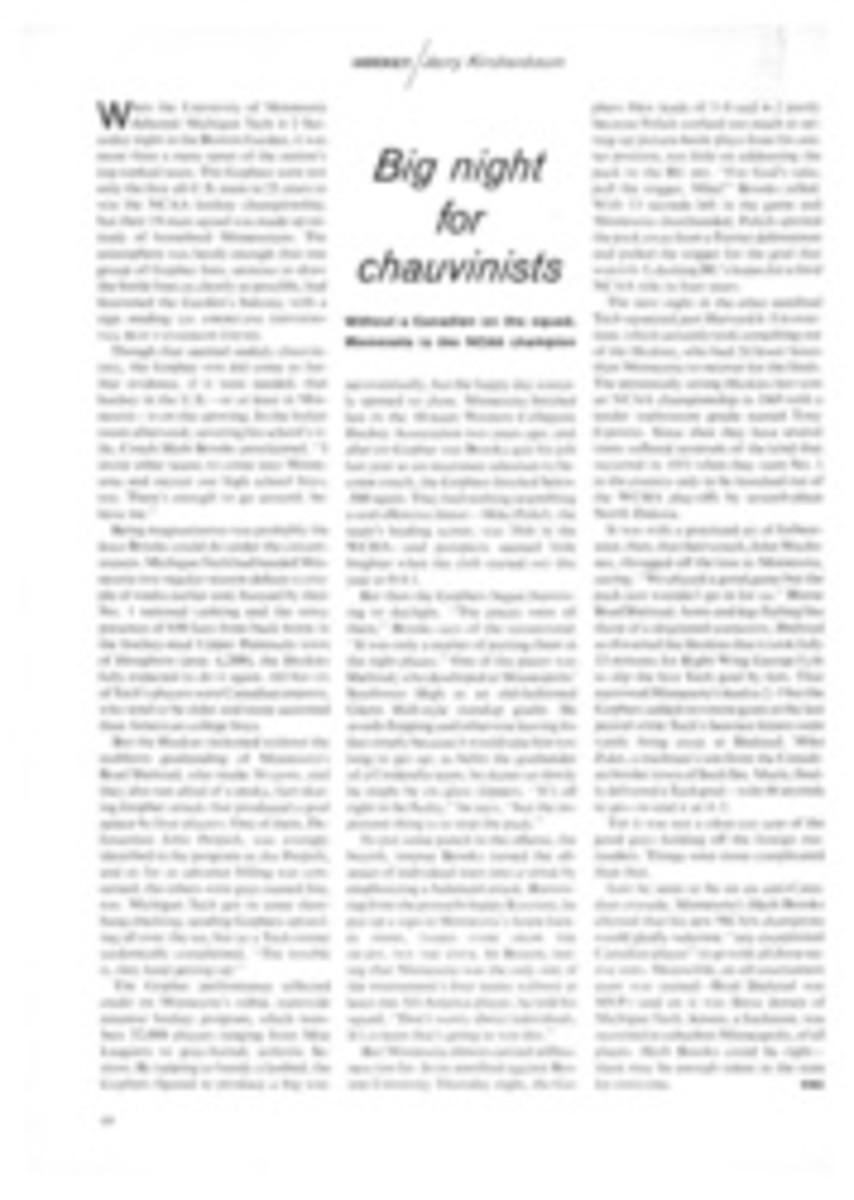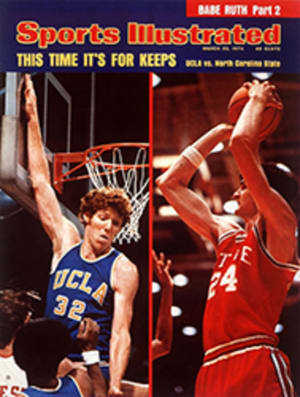
Playing like an amateur
It has been eight years since Europe reached out a hand to the ignorant and despairing survivors of the great collapse of organized billiards in the United States. The game had fallen into such disrepute that pristine billiard parlors were scattered across the country like monastaries in a Dark Age of poolroom barbarism. In 1966, however, the persevering ones looked up from their green cloth geometry and found themselves under the benevolent regard of the World Union of Billiards, an amateur organization with Olympic hauteur. The United States was to be allowed into the world competition against the best players from European affiliates representing a quarter of a million shooters. Surely, the renaissance of American billiards was dawning.
The national three-cushion championship of the Billiard Federation of the U.S.A., a member of the World Union, was held last month in San Jose, a suburb of Los Angeles illogically located in the San Francisco Bay area. The tournament ran for five days, with games in the afternoon and evening, before whispering, rapt audiences in the San Jose Elks Lodge. There were nine competitors engaged in round-robin matches. Attention centered on Gentleman John Bonner, the courtly 65-year-old American champion who went to the 1973 world games in Cairo. He was defending his title against top contender Frank Torres, an unruffled young man who at the age of 14 first picked up a cue stick in the Club de los Intelectuales in Mexico City.
A hundred paces from the hushed room where this sporting drama was unfolding on the last day of the tournament a few of the guys at the Elks bar remained mildly mystified. That it was a classy event was certain: the players walked around the club with their personal cue sticks in leather cases. The discussion at the bar was over what the players hoped to win. How big was the prize money? Naw, interrupted the bartender with the authority of a man uncapping a beer, the prize was a trip to Europe.
"Bums play pool," the late Danny McGoorty once remarked. "Gentlemen play billiards." Although McGoorty, a superb player and the last of the hard-drinking career hustlers, was perhaps inelegant, he shared the reverent attitude of those billiard commentators who like to cite a reference to "billards" in Shakespeare's Antony and Cleopatra.
The game developed in England and France at about the same time. But while the English added pockets to their tables, the French traditionalists persisted with four unbreached rails and three balls, the knocking together of which in certain sequences produced points. Perhaps it was the sentiment of the Revolution, but the French game was predominant in America in the last century. It was largely a matter of poking a stick at a sphere until the 1820s, when someone invented the leather tip and discovered that if you applied chalk to the end it tremendously increased the coefficient of friction. In other words, you could make the cue ball swerve and back up sharply like it had a mind of its own. With the technological breakthrough billiards became to pocket billiards, or pool, what chess is to checkers.
The French were preeminent in their own game, particularly a version of billiards called balkline. In 1906 Willie Hoppe, a solemn American youth in a tuxedo, played balkline with Maurice (The Lion) Vignaux in the ballroom of the Grand Hotel in Paris. In the U.S. knots of people gathered around newspaper offices and cheered wildly when news of Hoppe's victory was posted. Fifty years of American supremacy in billiards had begun.
In the flush of the golden era of the 1920s and 1930s there were an estimated 42,000 billiard and pool rooms in this country (there may be 10,000 today). These were the bivouacs of the army of fans who followed the highly paid exploits of Hoppe and the less legendary Welker (the Manson Marvel) Cochran, Jake Schaefer Jr. and a handful of other Americans no one else in the world seemed able to beat. The most popular game was three-cushion billiards, which could be so fiercely intellectual that newspapers published diagrams of the classic shots.
In 1952 Cochran, slowed down by arthritis, sponsored a world tournament in his billiard room in San Francisco. He didn't play; Hoppe did and won. There was one last professional world-class tournament in 1953. And that, although no one was aware of it, was that.
"When I got to San Francisco it was like a billiard paradise for a young lad from Dubuque," recalled Robert Byrne, billiard historian and McGoorty's biographer. "Unfortunately, that was in 1954, when the game was going into almost total eclipse. The organization collapsed. There was no way of finding out what was happening. There were a few big cities where three-cushion was still played and a few oldtimers still played balkline. But nobody knew what was happening abroad. Everybody sort of assumed that with the United States gone, the game had died everywhere."
Billiards, in fact, was in bursting good health elsewhere. In their prime Hoppe and Cochran had three-cushion tournament averages of 1.150—the average number of points scored per inning, or turn, at the table. That was regarded as billiards at its finest. A Belgian named Raymond Ceulemans won the amateur world championship in 1963 and has held the title ever since. His average is an amazing 1.277.
When the World Union of Billiards welcomed America back into international play, it was with the understanding that U.S. federation members would be untainted by the wheeling-dealing commercialism that had provided the gold of the golden era in this country. This covenant was entrusted to Dr. Virgil E. Erickson, the president and a founder of the U.S. group. The choice was well made. Doc has the stature of Avery Brundage in billiards.
Doc Erickson has watched international-class amateur competition on several occasions, and he admits that American players have a distance to go, the first step being the admission that the art has fallen to a low state in this country. Realizing this, however, Doc had no compunction about agreeing to the suspension of Al Gilbert, one of the federation's protégés and probably its best three-cushion player. Gilbert had taken part in an unsanctioned prize-money match in Mexico.
Doc is undeterred, even though Eastern representation at his national tournaments has disappeared because of his strictures on commercialism. He is a man who owns Welker Cochran's private table, a beautiful piece of massive inlaid furniture, and plays billiards with a cue stick he bought 44 years ago when he was 12. It is at Doc's strong suggestion that the competitors in his tournaments wear suits or dark cardigans while at the table as a substitute for the satin-sleeved vests worn in Europe. "We want the players to look presentable, not like bums," he says.
The competitors at the 1974 nationals in the San Jose Elks Lodge wore dark sweaters, with the exception of Gentleman John Bonner, a retired steel company supervisor from Buffalo. He earned his moniker by never removing his jacket when he plays. His title was taken from him, however.
On April 2-7 in Antwerp the United States will be represented in the World Billiard Championship by Frank Torres, an American who speaks English with a Spanish accent. Torres, at 29 the kid of the tournament, was undefeated in San Jose, beating Bonner 50-33 in their final game. The most exciting aspect of the tournament was whether Torres would maintain the .750 average demanded by the World Union of every player entering its championship. Torres drove up his average to the minimum only in the last game.
Torres was born in San Antonio but was raised in Mexico City, where pool is little known. It wasn't until 1968, after college, that he returned to his native country. His interest in school had been mathematics and Torres had decided to become an electronics technician. His weekends were devoted more and more to billiards.
"I asked questions of the good players," he says. "Al Gilbert was one of them. And when I had a system that wasn't improving my game, I dropped it. That is hard to do, but you must if you want to get better.
"Now at the table I can see the angle clearly, I can split it in my mind very easily and calculate the cushions. The most important thing is to forget your opponent. Don't watch his style, his stroke. After finishing the shot, you stop thinking."
When Torres goes to Belgium, it will be his first exposure to great players such as Ceulemans, who was not much older than Torres when he became world champion. What is his plan of action at Antwerp? Torres thinks for a moment, then smiles brilliantly.
"Ask questions," he says.
PHOTO

